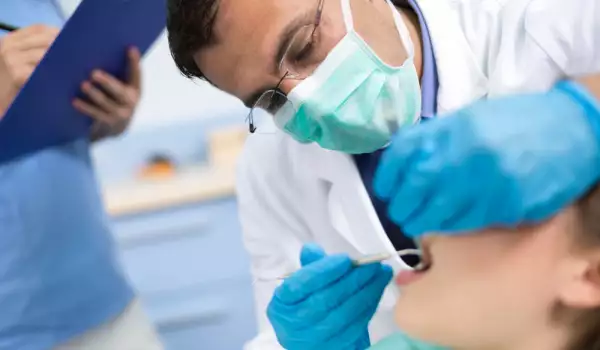Fluoride is a trace element that is closely related to the health of teeth and bones. It affects the dentin and enamel of the teeth and is believed to be of great importance in the prevention of caries in properly defined doses.
The biggest source of fluoride is water, but people also get it from food supplements, fluoride toothpaste, through food.
In some countries it is added to milk, bread and other food products. Although it is so common, it should be known that an overdose of fluoride can be dangerous to health and controlling the amount of fluoride given to children is of great importance. From here, it should be concluded that fluoride is both healthy and harmful - especially for the little ones.
There are many disputes about the question of how healthy fluoride is and whether its harms do not many times exceed its possible benefits. According to some specialists, it has no specific benefits for teeth and bones and according to others, it is necessary, but should not be overdosed.
Benefits of Fluoride
Ingested fluoride reaches the tooth enamel through the saliva. It gets there through the intake of water, drops and tablets with fluoride or food. Fluoride can also be introduced through the use of fluoride toothpastes.
In bone and tooth enamel, a mineral formed from calcium and phosphorus predominates, which is called hydroxyapatite. With the participation of fluoride, this mineral is transformed into another mineral - fluorapatite, which makes bones and teeth much stronger and serves as a barrier against bacteria.
This is also the main role that fluoride plays. In the absence of sufficient fluoride, fluorapatite is converted back to hydroxyapatite and therefore the enamel becomes weaker. Then the bacteria in the saliva and dental plaque slowly break it down and caries form.
Fluoride overdose
Fluoride overdose can happen in several ways. First of all by taking drops or tablets and secondly – increased intake with water. Very rarely, an overdose of fluoride from food can occur. Prolonged overdose of fluoride is very dangerous, because it can lead to the dangerous condition fluorosis.
Fluorosis is a change in bone structure and the bones become weak and brittle, a condition known as skeletal fluorosis. The other negative effect is fluorosis of tooth enamel, which causes destruction. It is important to know that teeth affected by fluorosis are very difficult to treat.

Fluorosis is not only an aesthetic problem, but also a serious health problem that should not be underestimated at all. In the mildest form of dental fluorosis, white and brown spots are seen on the crown of the teeth.
In more severe forms, the teeth can completely change their color, become very friable and unstable, which leads to the rapid development of caries and destruction soon after drilling. Fluorosis is primarily a disease in children during tooth development and is not treatable. Children under the age of 4 are most at risk, but the risk remains until the age of 8.
There are a number of claims that fluoride overdose can cause fertility problems and even cancer, but the World Health Organization rejects them. However, WHO reports the harmful effects of its overdose on teeth and bones. For this reason, both children and adults should be careful with its intake.
Fluoride prophylaxis
Children's teeth are mineralized in 2 main stages - before and after they erupt. Endogenous prophylaxis is performed before eruption and exogenous prophylaxis is performed 2 years after the eruption of each tooth.
Endogenous prophylaxis consists of internal intake of fluoride through food, tablets and water. It is applied in order to fully mineralize the enamel and ensure high resistance of the teeth. Endogenous prevention refers to the purposeful intake of fluoride through food supplements, fluoride-enriched water, etc.
During pregnancy, the targeted intake of fluoride carries a real risk of overdose. It is dangerous for the fetus, where the mineralization of the milk teeth is not complete. The period from the birth of the baby to the completion of 1 year is completely sufficient for the implementation of the endogenous prevention of teeth.
Exogenous prophylaxis – is the application of fluoride directly to tooth enamel through gels, solutions and toothpastes. This prophylaxis is applied for local protection after teething.
Permissible daily doses of fluoride
Since the harmful effects of fluoride overdose are very serious, it is important to know what the recommended daily dose is. For adults, this is 2-4 mg per day of fluoride. For children up to 3 years of age, 0.8 mg is permissible, for 3 to 6-year-olds it is up to 1 mg and for over 10-year-olds, the daily dose should not exceed 1.3 mg.
Sources of fluoride
There are several main sources of fluoride. First of all, it can be obtained from food additives additionally enriched with fluoride. Drinking water is the next good source, unfortunately it carries the greatest risk of unknowingly exceeding the daily maximum.
Toothpaste and mouthwash are other sources of fluoride. The rule that the amount of a pea is needed to brush the teeth is very important here. Younger children should brush their teeth under adult supervision because there is a risk of swallowing.
The amount of fluoride depends on the levels in the water used to make it. Even commercial teas sold in bottles and boxes may contain some fluoride.
Fruit juice
However, fruit juice is also high in sugar, which can damage teeth.

Shrimp
Shrimp are also cited as a fluoride food.
Coffee
The amount of fluoride coffee contains will depend on the water used to prepare it.
Red wine
You should be careful with red wine. No more than 1 glass a night is recommended.
Raisins
Raisins are also believed to be a source of fluoride. However, raisins are high in sugar and can get stuck between the teeth. As such, they can increase the risk of tooth decay.
Sources of fluoride, although in small amounts, can be beer, carrots, red bean soup, boiled potatoes, oysters, potato soup, etc.
Fluoride deficiency
Fluoride has the incredible ability to reduce tooth decay. It even helps to restore and mineralize teeth when caries are still in their early stages. All this makes fluoride one of the best ways to fight tooth decay.
When a person does not get enough fluoride, it can lead to increased cavities and even osteoporosis.
Learning how to recognize the three warning signs of fluoride deficiency can help you identify a problem before it progresses.
The first sign of fluoride deficiency is usually an increase in the number of caries. This should be a red flag because the bacteria found in plaque collects on the teeth. Plaque uses sugars and carbohydrates to produce acids. These acids then wear away your enamel. If you have tooth decay, it doesn't necessarily mean you have a fluoride deficiency. Cavities have other causes, including consuming too much sugar and poor oral hygiene.
Lack of fluoride can cause tooth enamel to weaken and be prone to decay. The acids in plaque remove the minerals in the hard, outer layer of your teeth. This type of erosion causes small holes or holes in the enamel, the first stage of tooth decay. Once areas of enamel wear away, bacteria can reach the deeper layers of your teeth and cause larger cavities.
Remember that your body needs fluoride for healthy bones in addition to healthy teeth. If you suffer from a true fluoride deficiency, you are at increased risk of weak and brittle bones. Elderly people diagnosed as prone to bone fractures may have an underlying fluoride deficiency that contributes to their weaknesses and disturbances.

One of the signs of fluoride deficiency can be the appearance of white spots on the teeth. If you experience such a problem, ask your dentist about it.
Easy ways to include fluoride in our menu
There are a few simple ways to help your body get fluoride if your levels are deficient. Most steps can be taken at home, while other methods require a visit to your dentist.
Drink tap water
Fluoride has been safely added to public water systems for more than 70 years. Additionally, community water fluoridation has been shown to be safe and effective with consistent scientific evidence and studies. Most community water systems fluoridate drinking water supplies. According to the Centers for Disease Control, consumption of fluoridated water reduces tooth decay by 25% in children and adults.
Use fluoride toothpaste
Toothpaste is one of the main sources of fluoride. Always look for a toothpaste that contains at least 1250 ppm fluoride. For a personalized toothpaste recommendation, ask your trusted dentist which toothpaste is the best option for your smile.
Use fluoride mouthwash
Some brands of mouthwash contain fluoride, which helps mineralize soft spots and strengthen your tooth enamel. Not all mouthwashes are the same and not all mouthwash brands contain fluoride. Always check the label to make sure you are buying the best mouthwash for teeth.
Include professional fluoride treatments
If you are concerned that you are not getting enough fluoride, discuss professional fluoride treatment with your dentist.
















Comments